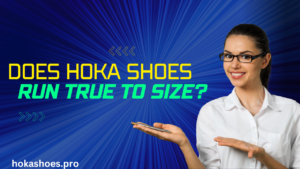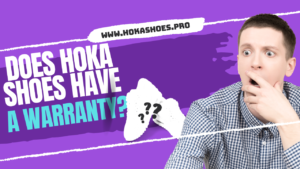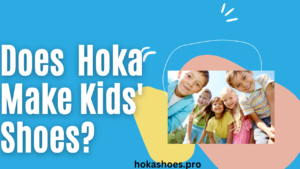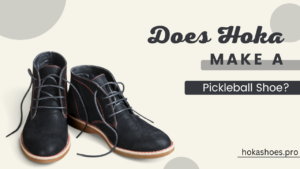
Everything You Need To Know About Hoka Shoes
Hoka shoes are a relatively new brand of athletic and running shoes that have quickly grown in popularity in recent years. Hoka One One, the company behind the shoes, was founded in 2009 by French runners who were looking to create a shoe that offered maximum cushioning and support to improve running efficiency and comfort.
Within just a few years, Hoka shoes have gone from a niche product to being worn by numerous professional and amateur runners, hikers and athletes. They are best known for their thick midsoles and oversized appearance, which has earned them nicknames like “clown shoes.” However, the distinctive look comes with proven benefits that have made them a top choice for various sports and fitness activities.
Key Features of Hoka Shoes
Thick Cushioned Midsole
The most distinctive feature of Hoka shoes is the thick midsole, which offers more cushioning than traditional running shoes. Many Hoka shoes have a midsole height of around 30-35mm compared to 10-15mm in typical shoes. This added cushioning aims to provide enhanced shock absorption and a more comfortable ride without losing responsiveness. The thick midsole also adds to the overall height and chunky profile of Hoka shoes.
Rocker Sole Design
Many Hoka shoes employ a rocker sole design, where the heel is slightly elevated and the forefoot has a rounded profile. This encourages the foot to smoothly transition through each stride from heel strike to toe-off. The rocker design helps propel you forward using less energy and can reduce strain on the feet and legs during activities like long-distance running.
Lightweight Construction
Despite their size, Hoka shoes are surprisingly lightweight. State-of-the-art materials like high-abrasion rubber, breathable mesh, durable synthetics are used to create the chunky midsoles and outsoles without adding unnecessary weight. Keeping the shoes lightweight prevents fatigue and makes them suitable for athletic pursuits where heavy shoes could be a disadvantage.
Meta-Rocker Geometry
Hoka introduced its signature Meta-Rocker geometry on several shoe models. Meta-Rocker refers to a fulcrum effect where the outsole and midsole are designed to replicate your foot’s natural stride. This helps you maintain efficiency while running over the high stack height midsole. The Meta series of shoes are popular choices thanks to this geometry that enhances stability and smoothness through the stride.
Key Technologies
Hoka employs several proprietary technologies and materials in its shoes:
- Active Foot Frame: Uses supportive thermoplastic urethane rails along with the upper materials to cradle the foot and improve stability. Used in models like Arahi and Gaviota.
- ProFly: A dual-density midsole foams that combines softer foam at the heel and firmer foam at the forefoot to provide cushioning while maintaining responsiveness. Featured on Bondi and Clifton models.
- Early Stage Meta-Rocker: An evolution of the original design with a lower heel curvature and more rounded outsole shape for smoother heel to toe transition. Used on shoes like the Rincon and Mach.
- Zonal Rubber Placement: Strategic placement of durable high-abrasion rubber on high-impact areas for improved traction and durability. Seen on trail and hybrid shoes like Speedgoat and Evo Mafate.
- Breathable Air Mesh: Lightweight open air mesh material used on uppers allows ventilation and breathability during runs to keep feet cooler and drier.
Key Hoka Shoe Models
Hoka offers a wide selection of shoe models catering to different needs including road running, trail running, hiking, walking and fitness:
- Clifton: One of Hoka’s most popular road running shoes praised for its plush cushioning and smooth ride. Ideal for long distances.
- Bondi: Hoka’s maximum cushioning shoe with a 36mm heel, suited for recovery runs and runners needing extra impact protection.
- Rincon: Award-winning lightweight neutral shoe enabling faster paces due to the responsive foam and early stage Meta-Rocker.
- Arahi: Support shoe with midfoot structure and firm J-Frame for overpronators needing stability and cushioning.
- Speedgoat: Durable trail running and hiking shoe designed for gnarly mountain terrains with aggressive Meta-Rocker midsole and grippy outsole.
- Astral TR: Crafted for rugged trail adventures with waterproof leather upper to keep feet dry across rivers and unpredictable terrain.
Benefits of Using Hoka Shoes
The unique characteristics of Hoka shoes come with proven performance benefits:
- Exceptional Cushioning: Reduces impact shock and joint stress for injury prevention and post-run muscle soreness. This also improves comfort allowing you to go longer.
- Energy Return: The thick midsole absorbs and returns energy with each footstrike leading to a smooth, propulsive toe-off motion.
- Impact Reduction: Studies found running in Hokas leads to substantially lower peak impact compared to traditional shoes, reducing fatigue.
- Uphill Efficiency: The rocker-shaped outsole encourages forward momentum that conserves energy on climbs.
- Stability: Models like Arahi prevent excessive foot movements thanks to guide rails and structural support from midsole and upper.
When to Choose Hoka Shoes
Here are some common use cases where Hoka shoes perform exceptionally well:
- Long Distance Running: The enhanced cushioning makes them ideal for marathon training and runners logging high weekly mileage.
- Recovery Days: Provides extra softness for easier runs after intense training days to let your body recharge.
- Physical Jobs: Nurses, servers and others on their feet all day appreciate the cushioning technologies that reduce pain and fatigue.
- Hiking: Trail models offer downhill control and stability combined with cushioning to cover miles of rugged mountain terrain in comfort.
- Walking: Superior shock absorption and Meta-Rocker ease the foot strike and forward motion during walking for greater comfort over extended durations.
- Overpronation: Structured models like Arahi and Gaviota give stability and motion control for people needing support due to excessive inward foot rolling.
Getting Started With Hoka Shoes
If considering your first pair of Hokas, keep these tips in mind:
- Try them on in-store first whenever possible to get the right size and initial feel.
- Be prepared for the feeling of extra height underfoot compared to typical shoes and it adapting your gait.
- Start by using them for shorter runs of just a few miles as your feet, ankles and calves strengthen.
- When transitioning to Hokas, ease off from fast training paces temporarily until your body adapts to the new biomechanics.
- Understand that the visual profile is exaggerated but weight remains light for performance benefits.
- Consider using them primarily for recovery days and long miles before making them your everyday training shoe.
With the right model, transition adjustment and use case, Hoka shoes can take your running, hiking and fitness to the next level!
Conclusion
In just over a decade, Hoka One One has innovated a new category of athletic shoe that defies conventions. The extra thick midsoles and curved bottoms produce proven advantages from injury prevention to efficiency gains across various sports. As the technology and designs continue advancing, Hokas are cementing their status as a top footwear brand among serious runners, hikers and fitness enthusiasts who want to unlock new performance and comfort mile after mile.
FAQs
What are Hoka shoes?
Hoka shoes are a brand of running/walking shoes known for their thick, cushioned soles. Hokas have a lot more cushioning than traditional running shoes, up to 2-3 times more foam cushioning. This extra cushioning aims to provide a smoother, more comfortable run.
What types of Hoka shoes are there?
Some popular Hoka shoe models include the Bondi, Clifton, Rincon, Arahi, and Carbon X. There are road running shoes, trail running shoes, hiking shoes, and other athletic lifestyle shoes. They come in different amounts of cushioning from maximally cushioned to moderately cushioned.
For what activities are Hoka shoes designed?
Hoka shoes are designed primarily for running/walking on roads, sidewalks, trails, etc. The extra cushioning can help reduce impact to make runs feel easier on your legs and feet over long distances. Many people also use Hokas casually for things like travel, fitness classes, and everyday use.
What are the benefits of Hoka cushioning?
1. Reduced impact or feeling less shock/pain in your feet, ankles, and knees
2. More comfort on long runs by absorbing impact
3. Can enable faster running times due to less energy loss in the shoe cushion
4. Decreased muscle soreness and fatigue
Do Hoka shoes run small or large?
Hoka shoes tend to run small/narrow. It’s recommended to go up 1/2 to a full shoe size from what you normally wear. The toe box is also on the narrower side for most models. Trying them on before purchasing is highly recommended.
How long do Hoka shoes last?
The thick foam cushioning tends to compress and lose some bounce over time faster than other running shoes. On average, Hokas last around 300-500 miles before needing replacement, but this can vary based on your body weight and running surfaces.
Are Hoka shoes good for walking?
Yes, many people use Hokas casually for walking. The thick cushioning can make walking more comfortable, especially for those on their feet all day or with joint pain.
Are Hokas true to size?
No, Hokas tend to run small/narrow so sizing up 1/2 to a full size is often recommended to allow a comfortable amount of toe room. The toe box also runs narrow.
Do Hokas have arch support?
Most models have a moderate amount of arch support, but those needing extra support may need to use orthotics. The Bondi and Arahi models provide a bit more arch support than other options.
How heavy are Hoka Shoes?
Compared to a typical running shoe, they can be 1-3 oz heavier depending on the model due to the extra cushioning foam. But new foam formulations have made some models nearly as light as a traditional shoe.
Where are Hoka shoes made?
Hoka Shoes has factories in China, Vietnam and France. Certain models are only made in certain locations.
Are Hoka shoes good for hiking?
They offer some trail running/hiking shoes with grip suited for varied terrain. Cushion for long miles on trails appeals to some hikers, but they may not provide enough stability or traction for more rugged hikes.
Are Hoka shoes good for plantar fasciitis?
Yes, many people with plantar fasciitis find the thick cushioning helps reduce pain in this foot condition. The Clifton and Bondi are popular choices.
What is the warranty period for Hoka shoes?
New Hoka shoes have a 30 day trial period to test for satisfaction. If not worn beyond that initially, they can be returned. The manufacturing defect warranty covers up to a year from purchase.
Latest Posts
- What Stores Sell Hoka Shoes? [2024]

- Does Hoka Shoes Run True To Size? [2024]

- Does Hoka Shoes Have a Warranty? [2024]

- Does Hoka Make Kids’ Shoes? [2024]

- Does Hoka Make a Pickleball Shoe? [2024]

- Does Hoka Make a Leather Shoe? [2024]

- Who Sells Hoka Shoes In Canada? [2024]

- Does Fleet Feet Carry Hoka Shoes? [2024]
